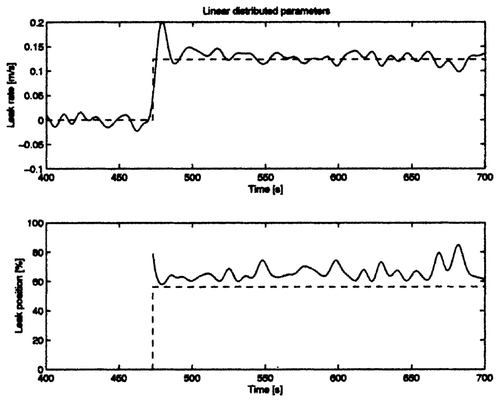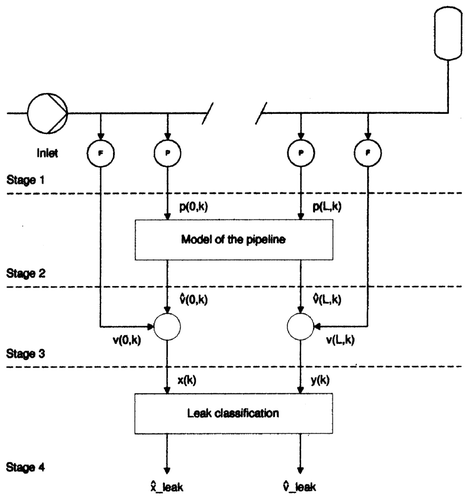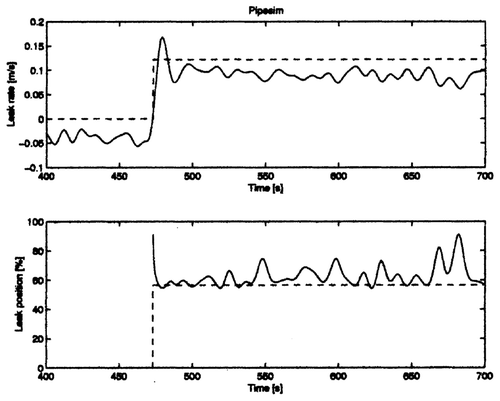Abstract
Four models of a pipeline are compared in the paper: a nonlinear distributed-parameter model, a linear distributed-parameter model, a simplified lumped-parameter model and an extended neural-net-based model. The transcendental transfer function of the linearized model is obtained by a Laplace transformation and corresponding initial and boundary conditions. The lumped-parameter model is obtained by a Taylor series extension of the transencdental transfer function. Based on the experience of linear models the structure of the neural net model, as an addendum to the nonlinear distributed-parameter model, is obtained. All four models are tested on a real pipeline data with an artificially generated leak.
1. Introduction
Many fluids transported by pipelines are in some sense dangerous. It is therefore often necessary to install leak detection (and locating) systems (LDSs), in particular because of legal regulations. Examples are as follows:
-
Code for Federal Regulations Title 49, Part 195 (USA);
-
American Petroleum Institute (API) 1130, 2nd edition (USA);
-
Technical Rules for Pipelines (Germany).
RRTM and E-RTTM LDSs are perhaps the most sophisticated systems for leak detection and location, but there are still unsolved problems.
-
Only models for single-phase liquid and gas flow are sufficiently exact; models for multiple-phase flow are available, but often too complex or too inaccurate.
-
Many crude oil pipelines are operated using drag-reducing agents (DRAs), which influence the static and transient behaviour of the pipeline significantly. Complete models for DRAs are not yet available.
-
Unknown factors such as sensor offsets or sensor dynamics often degrade LDS performance by falsifying the transient calculation.
-
Unmeasurable variables and parameters have an impact on the static and dynamic pipeline behaviour without the possibility of using analytical models for compensating these effects.
The aim of this paper is to compare different mathematical models with regard to their usage in the model-based leak-monitoring scheme introduced in Section 2. Section 3 presents the models for the observer design. The basic model is a nonlinear distributed-parameter model obtained by applying the principle of mass conservation and Newton's second law of motion Citation5. The next two models are obtained by linearization and Laplace transformation leading to multiple-input multiple-output models Citation6,Citation7. Two methods for the approximation of transcendental transfer functions with rational functions leading to lumped-parameter models (valid for low and high frequencies respectively) are given. The last model is a neural net model which is an addendum to nonlinear distributed-parameter model and is obtained by the generalization of one of the linear models. All four models are tested on real pipeline data with an artificially generated leak in Section 4.
2 Observer-based leak monitoring
Observer-based leak monitoring requires a pipeline model in the form of a pipeline observer to compute the pipeline states assuming no leak. Further discussion will be focused on a discrete-time data-processing scheme. The difference between the measured and estimated flows at inlet and outlet, given by
3 Models for the observer design
Observer-based leak detection and localization schemes require a pipeline model to compute the states of a pipeline without a leak Citation8,Citation9. The basic mathematical model of a pipeline is a nonlinear distributed-parameters model. It describes the one-dimensional compressible fluid flow through the pipeline and is represented by a set of nonlinear partial differential equations Citation10. No general closed-form solution of these equations are known yet, and numerical approaches such as the method of characteristics must be used instead Citation11. If the pipeline is operating in the vicinity of a working point, a linear model can be exploited. The transfer function of such a model is obtained by the Laplace transformation of the linearized equations and corresponding initial and boundary conditions. The resulting transfer function is transcendent. Simple models of the pipeline in the form of a lumped-parameter system can be obtained by a Taylor series expansion of transcendental transfer functions. The resulting algorithms are less time consuming and hence better suited to critical real-time applications. With neural net models the grey-box approach is used. They are only an addendum to nonlinear distributed-parameter models; their structure is obtained from linear models, as are the initial values of the weights. After teaching, a nonlinear model is obtained. All four mathematical models of the pipeline will be given next. For simplicity reasons, outputs of the models (which are actually outputs of observers) will be denoted by p and v rather than by [pcirc] and [vcirc] respectively.
3.1 Nonlinear pipeline model with distributed parameters
The nonlinear pipeline model with distributed parameters is obtained by the application of the physical principles of mass conservation and Newton's second law. Applying these equation leads, under the assumptions that the fluid is compressible, viscous, isentropic, homogenous and one dimensional, to the following coupled nonlinear set of partial differential equations Citation5,Citation11:
A general solution is not available; however, a transformation into the ordinary differential equation
3.2 Linear pipeline model with distributed parameters
The nonlinear
Equationequations (6) and Equation(7)
are linearized and written in a form using notation common in the analysis of electrical transmission lines. Also, the gravity effect can be included into the working point so that α = 0 is supposed. The corresponding system of linear partial differential equation is
3.3 Linear pipeline model with lumped parameters and low frequencies
Lumped parameters are described by rational transfer functions. One way to obtain the rational transfer functions from the transcendental functions given by Equation(15) – Equation
Equation
Equation(18)
, is their extension into a Taylor series. There are seven different transcendental transfer functions in the four pipeline forms of Section 3.2: 1/cosh(nLp), 1/ZK
tanh (nLp), ZK
tanh(nLp
), ZK
coth(nLp
), ZK
sinh (nLp), 1/[ZK
coth(nLp)] and 1/[ZK
sinh (nLp)]. Each of the transcendental transfer functions of the impedance and admittance forms can be presented as a second-order transfer function. These models are only valid for low frequencies. Only admittance representations used in the observer-based leak monitoring will be given here and they are as follows.
-
Admittance representation: 1/ZK coth (nLp). The input admittance at the downstream reservoirs (V 0/P 0) PL = 0. The negative output admittance at the upstream reservoirs (VL /PL ) P 0 = 0. Also
This transfer function describes the change in the flow velocity at one end of the pipeline if the pressure is changing at the same end while the pressure at the other end remains constant. -
Admittance representation: 1/[ZK sinh (nLp )]. The negative reverse transadmittance at the upstream reservoir is −(V 0/PL )|P 0 = 0. The transadmittance at the downstream reservoir is (VL /P 0)|PL = 0. Also
This transfer function describes the change in the flow velocity at one end of the pipeline if the pressure is changing at the other end while the pressure at the same end remains constant.
3.4 Linear pipeline model with lumped parameters and high frequencies
The models derived in Sections 3.1 –
3.3 are valid predominantly in the low-frequency region. They do not include such phenomena as propagation of waves along the pipeline. Rather, oscillations due to the finite velocity of the waves is described as a second-order underdamped system. In this section a linear model will be derived which enables the preservation of the time delays inherently involved in distributed-parameter systems, such as pipelines. The flow at the outlet of the pipeline can be expressed from Equation(18) as follows:
3.5 Neural net model of the pipeline
The models derived in Sections 3.2 –
3.4 are linear models. The pipeline is, however, a nonlinear process. Neural nets are capable of modelling nonlinear phenomena; so it seems to be reasonable to apply them. However, neural nets are essentially lumped-parameter systems. Lumped-parameter models in Section 3.3 were obtained from distributed-parameter models in Section 3.2 by expanding the transcendental transfer function in Taylor series. Such models can easily be realized by a neural net; in fact there is only one linear neuron and some delays at the input and feedback. So one way to construct a neural net model is to extend a linear lumped-parameter model, that is a linear neuron, by one or several layers. A drawback of this model is that it does not involve the time delays that are inherently involved in a distributed-parameter model. Another way to design a neural net model of the pipeline is to use the models of Section 3.4. An attempt to approximate the transcendental transfer functions 1/ZK
= (Cs)1/2/(Ls + R)1/2 and −exp((Ls + R)Cs)1/2
L
P by rational functions was made in Citation13. Following the same paradigm a neural net could be designed but, since the square root has no Taylor series expansion around zero (in the above-mentioned paper the expansion was carried out by the Padé approximation and is not valid for s = 0), the long-term stability of such models is doubtful. The approach used in this paper is similar to the previously mentioned method; however, the neural net is used for correction only. The actual pipeline neural net model consists of two parts. The basic part is the nonlinear distributed-parameter model (the so-called PIPESIM model). Parallel to it there is a neural net correction model, with outputs [vtilde](0, k) and [vtilde](N, k), which are corrections of the inlet and outlet velocities respectively. The design of the neural net (and in particular the determination of the structure) is a matter of engineering feeling. Of great assistance in the present case are Equation(25) and Equation(30)
, which indicate that the flow at the inlet depends on the pressure at the inlet (transfer function 1/ZK
), on the pressure at the outlet (transfer function e-nLp/ZK
) and on the flow at the outlet (transfer function e−mL
p
). The sampling time of the neural net was chosen to be the same as for the PIPESIM program (0.1191 s). The number of segments in the PIPESIM model was N = 87. The transfer function e-NLp involves a time delay (the time needed by waves to travel along the pipeline is N time steps). So N-step delayed signals of p(N) and v(N) are used as input to the neural net. An additional n input delays are used to enable the neural net to correct dynamic phenomena, which are not involved in the PIPESIM model. n was chosen to be 11, which is within 10 – 15% of the dominating time delay N. So the inlet and outlet velocity corrections can be written as
4 Application to a real pipeline
The models were tested using data obtained by a leak experiment on a real pipeline with the following data: pipeline length of L p = 9854 m; diameter D = 0.2065 m, relative roughness k c = 0.0602 mm; inclination α = −0.1948°. The fluid data were as follows: density ρ = 680 kg/m3; kinematic viscosity υ = 7.0 × 10−7 m2/s; source velocity α = 951 m/s. The stationary fluid velocity prior to the leak occurrence was 2.45 m/s. A 5% leak rate (0.1225 m/s corresponding to 14.77 m3/h) was generated at t = 437 s at 56.4% of the pipeline length where the outrunning fluid was filled into a tank lorry.
The parametrization of programs, a provision of the necessary data for the determination of the unmeasurable relative roughness of the pipeline and neural net training – verification data, was performed by another no-leak experiment with similar (2.46 m/s) stationary fluid velocity. In this experiment a shunt valve at the beginning of the pipeline was closed, leading to a quick drop in pressure and causing fluid transients. For the PIPESIM program, only the relative roughness was calculated from the stationary working point. For both linear models additionally the stationary working points (at the inlet and outlet respectively) of the above-mentioned experiment were used. The neural net was trained by the residuals (without leak) of the PIPESIM results. The TRAIN function of the MATLAB®'s Neural Net Toolbox Citation14 was applied using the Levenberg – Marquardt back propagation. The sizes of training and verification data were 12 000 and 9744 samples respectively and the number of epochs was set to 250.
In , , and the filtered estimated leak rate and leak location are depicted for the PIPESIM model, the linear distributed-parameter model, the linear lumped-parameter model and the neural net model respectively. The leak position was evaluated only if a threshold of 2% was exceeded. Standard deviations (with respect to the real mean values) and deviations of the mean values of the rate and position errors for all models in percentages are depicted in .
Figure 4. Estimated leak rate (upper) and estimated leak location (lower) for the linear distributed-parameter model.

Figure 5. Estimated leak rate (upper) and estimated leak location (lower) for the linear lumped-parameter model.

Table 1. Standard deviations and the deviations of the mean values of the rate and position errors for all models.
The PIPESIM program results were biased in the estimations of both the leak rate and the position. This was due to the bias in the fluid velocity sensors and due to the non-modelled dynamics. The bias of the sensors which were not eliminated with the PIPESIM program, and which contributed a major part to its bad rating, could be eliminated with some drawbacks, as explained in the conclusion. However, the neural net did exactly this in a more systematic way, which additionally incorporated the elimination of errors due to some non-modelled effects. All other models exhibited a small bias (approximately 3%) for the leak rate. This was probably due to the approximate evaluation of the real leak rate, which was obtained manually (it was not measured and registered); that is, the real leak rate was not 5% as considered in the evaluation, but 5.15%. Linear models used the working point of a similar experiment; so the offsets in leak rate (which are actually the differences of residuals) were eliminated. However, bias in the estimate of the leak position remained owing to non-modelled effects. Some of these effects were incorporated in the neural net model, which had the smallest bias of the estimated position.
5 Conclusion
Four models of the pipeline were used for leak detection and localization. The nonlinear distributed-parameter model was simulated using a special program PIPESIM. In its original form it served biased (in leak rate and position) results due to offsets in sensors and some non-modelled effects. Linear models eliminated the sensor offsets by definition; that is, offsets were eliminated by a longterm averaging technique. However, they provided useful results only for very small changes in the signals around a working point. Also they could not cope with comprehensive nonlinear effects of the pipeline; so the leak position estimate was biased. Best results were obtained with a neural net model as an addendum to the PIPESIM model. The neural net eliminated the sensor bias and incorporated some nonlinear effects which were not modelled by the PIPESIM program.
References
- Geiger , G. 1999 . “ Leak monitoring in pipelines—state of the art ” . In Seminar Fernleitungen der Landesanstalt für Arbeitschutz Kaiserau, , Germany 3 – 5 November 1999
- Geiger , G. , Werner , T. and Matko , D. 2003 . “ Leak detection and locating—a survey ” . In Proceedings of the 35th Annual Pipeline Simulation Interest Group Meeting Bern, , Switzerland 2003
- Isermann , R. 1994 . “ Integration of fault detection and diagnosis methods ” . In Proceedings of the IFAC Symposium on Fault Detection, Supervision and Safety for Technical Processes Espoo, , Finland 1994
- Geiger , G. 1998 . “ Application of a model-based method for leak detection and localization ” . In GMA-Kongress Meß- und Automatisierungstechnik, VDI Berichte 1397 18 – 19 June 1998
- Streeter , V. L. , Wylie , E. B. and Bedford , B. 1998 . Fluid Mechanics , 9th edition , New York : McGraw-Hill .
- Matko , G. , Geiger , G. and Gregoritza , W. 2000 . “ Verification of various pipeline models ” . In Proceedings of the 3rd International IMCAS Symposium on Mathematical Modelling Vienna, , Austria 2 – 4 February 2000
- Matko , D. , Geiger , G. and Gregoritza , W. 2000 . Pipeline simulation techniques . Mathematics and Computers in Simulation , 52 : 211 – 230 .
- Billmann , L. 1985 . Methoden zur Lecküberwachung und Regelung von Gasfernleitungen , Germany : Technische Hochschule Darmstadt . Thesis
- Siebert , H. 1981 . Untersuchung verschiedener Methoden zur Lecküberwachung bei Pipelines , Germany : Technische Hochschule Darmstadt . Thesis
- Streeter , V. L. and Wylie , E. B. 1978 . Fluid Transients , New York : McGraw-Hill .
- Anderson , J. D. 1996 . “ Basic philosophy of CFD ” . In Computational Fluid Dynamics , 2nd edition , Edited by: Wendt , J. F. Berlin : Springer .
- Streeter , V. L. and Wylie , E. B. 1993 . Fluid Transients in Systems , London : Prentice-Hall .
- Matko , D. and Geiger , G. 2002 . Models of pipelines in transient mode . Mathematical and Computer Modelling of Dynamical Systems , 8 : 117 – 136 .
- The MathWorks, Inc. Neural Network Toolbox License number 190357



